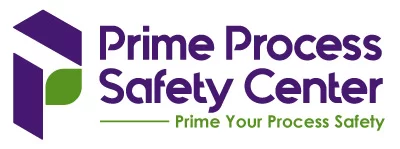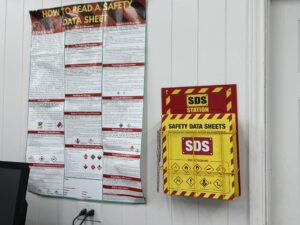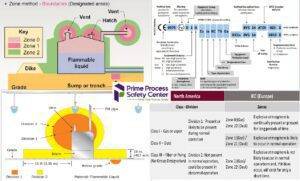We also offer
What is pH Test
pH is a measure of the hydrogen ion concentration in a solution, indicating its acidity or alkalinity on a scale ranging from 0 to 14. A pH of 7 is considered neutral, below 7 is acidic, and above 7 is alkaline (basic). Neutral substances have an equal concentration of hydrogen ions and hydroxide ions. Acidic substances have a higher concentration of hydrogen ions, while alkaline substances have a higher concentration of hydroxide ions.
pH measurement is important for regulatory compliance across industries such as wastewater treatment, food and beverage production, and pharmaceutical manufacturing to ensure adherence to specified pH ranges. Accurate pH determination is also essential for chemical handling and storage, as highly acidic or alkaline substances can pose significant safety risks.
At Prime Process Safety Center, our advanced pH meter accurately determines the pH of solid, semi-solid, and liquid materials quickly and reliably.
When to Perform pH Test
Determining pH is essential in process safety and quality control across many industries due to its impact on chemical behavior, corrosion potential, and environmental safety.
1. Chemical Safety and Corrosivity
pH measurement is vital when dealing with corrosive substances. Acids and bases with extreme pH levels can react with storage containers or incompatible materials, causing leaks or spills. Knowing the pH helps determine proper storage conditions, compatible containers, and appropriate handling procedures to prevent accidents or chemical reactions.
2. Worker Health and Safety
In workplaces where employees handle chemicals, understanding the pH of substances is critical for ensuring worker protection. Highly acidic or alkaline solutions can cause burns, skin irritation, or respiratory issues. Regular pH testing helps implement proper safety measures and select appropriate personal protective equipment (PPE) to minimize risks.
3. Environmental Protection
pH measurement is also key in assessing the environmental impact of effluents, wastewater, or chemical spills. Discharging materials with extreme pH values can damage aquatic ecosystems. Monitoring pH levels allows facilities to neutralize or treat substances before disposal, ensuring compliance and preventing environmental contamination.
4. Emergency Response
In the event of a chemical spill or accident, determining the pH of the spilled material is crucial. Knowing the pH enables emergency responders to select the correct neutralizing agents and containment methods, minimizing potential harm or injury.
Why Choose Prime Process Safety Center
Prime Process Safety Center is a trusted leader in process safety testing, supported by a team of highly experienced laboratory professionals.
-
We deliver accurate, reliable, and defensible pH data that meet both industry and regulatory standards.
-
We use state-of-the-art pH testing equipment, ensuring precise and sensitive measurements.
-
We follow strict testing protocols and quality control procedures to maintain consistency and reliability.
- As an ISO/IEC 17025:2017 accredited laboratory, we follow rigorous quality and competency requirements for every test we perform.
-
Our team provides data interpretation and practical recommendations, helping you apply results to your specific safety or compliance needs.
FAQ
How can pH testing be conducted, and what are the reliable methods for measuring pH?
pH testing can be performed using pH meters, test strips, or colorimetric indicators. Each method has its accuracy and suitability for different applications. Using calibrated pH meters for precise measurements or test strips for quick assessments, individuals can determine pH levels accurately. Regular calibration and maintenance of pH testing equipment are essential for reliable results.
What safety precautions should be taken based on the pH of chemicals?
Depending on the pH of a substance, various safety precautions are warranted. For highly acidic or alkaline chemicals, proper personal protective equipment (PPE) such as gloves, goggles, and protective clothing should be worn. Adequate ventilation, segregated storage, and spill containment measures are necessary to prevent accidents and exposure.
How can pH impact safety when handling or storing chemicals?
pH directly affects safety considerations during chemical handling and storage. Highly acidic or alkaline substances can corrode containers, posing risks of leaks or spills. They can also cause chemical reactions with other materials, potentially leading to accidents or releasing hazardous fumes. Knowledge of pH guides proper storage conditions, compatible materials, and necessary precautions to prevent incidents.
Why is it important to know the pH of chemicals?
Knowing the pH of chemicals is essential as it helps determine their potential reactivity, corrosiveness, and health hazards. Highly acidic or alkaline substances can cause burns, skin irritation, or environmental harm if improperly handled or disposed of. Understanding pH aids in implementing appropriate safety measures and handling procedures to mitigate risks.
What is pH, and how does it relate to chemical safety?
pH measures the acidity or alkalinity of a substance on a scale from 0 to 14, where 7 is neutral, below 7 is acidic, and above 7 is alkaline. Understanding pH is crucial in chemical safety as it helps assess the corrosiveness or potential hazards of a substance. Lower pH levels indicate higher acidity, while higher pH levels indicate alkalinity, influencing safety protocols for handling and storage.















